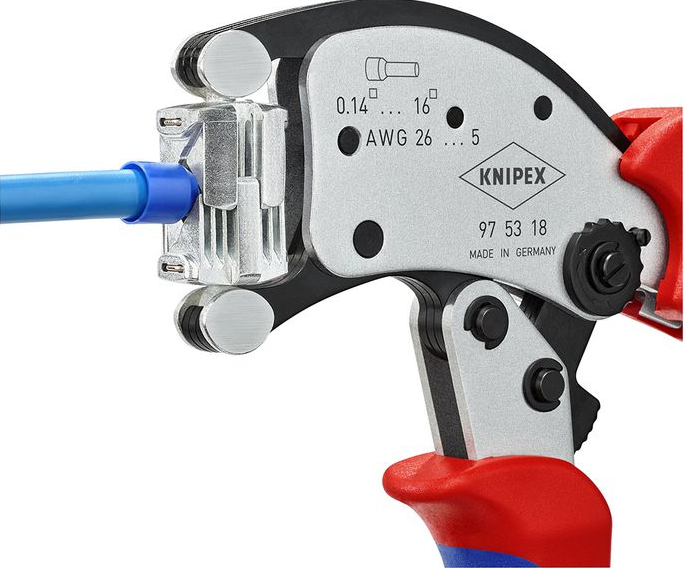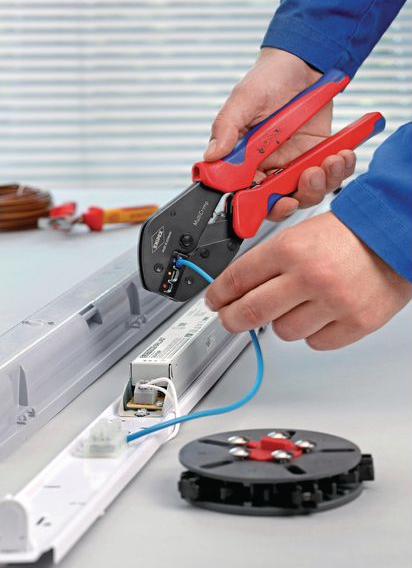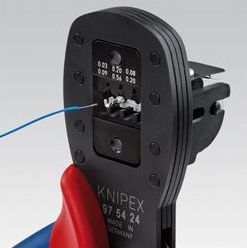Discover crimping products from the leading plier manufacturer and easily create a reliable connection for your wires.
Based in Germany, KNIPEX is the leading producer of pliers in the world. For over 140 years in the industry the brand has been producing pliers, pliers wrenches, and other tools that are designed with its extensive pliers knowledge and manufacturing expertise. Although its tools are mostly used by professionals in a variety of trades, DIY and EDC use is also growing in popularity. The company provides options for efficient, simple, and safe working.
To find out more about crimping and crimping tools, read on.
What is crimping?
A wide range of instruments known as crimp or crimping tools are used to attach materials or components by pressing them together to form a seal or crimp.
Crimping is frequently employed in electrical work and its primary use is to attach connections to the ends of electrical wires. Its other usage is in manufacturing, where engineers and mechanics crimp a variety of objects. As mentioned in the introduction, it can also be used for domestic and everyday usage.
The fittings used for the electrical connection to the wire are known as “crimp connectors”, and they typically consist of a metal connector with an insulated sleeve attached. The goal of the crimping tool is to create a reliable connection that is completely sealed against gas and moisture to avoid shortages and poor electrical connections.
Different types of crimping tools
Crimping tools exist in a variety of sizes and forms, and they’re employed for a variety of purposes, but their primary function is to form a solid and dependable connection.
Bootlace crimping tool
Bootlace ferrules, as the name implies, need a different type of crimping than normal cabling, hence bootlace crimp tools are made specifically for use with bootlace ferrules. They can accommodate a variety of common wire widths and are frequently used in screw terminals to prevent numerous core wires from separating.
In order to prevent the dies from being released before a secure connection has been achieved, the majority of bootlace crimping tools have ratchets and are electrically insulated. For added comfort when using, search for crimpers with ergonomic handles.
Knipex has a wide range of self-adjusting crimping pliers for crimping wire ferrules. Have a look at some below.

Self-adjusting crimping pliers – Twistor16
Features:
- Self-adjustment to the desired size of end sleeve (ferrule)
- 360° rotatable crimping die; with 8 tactile locking positions
- Crimping of twin end sleeves (ferrules) up to 2 x 6 mm² possible
- Slim head for ideal accessibility
- Repetitive, high crimping quality due to integral lock (self-releasing mechanism)
- Favourable lever ratio due to toggle lever
- Handy shape and low weight provide high operation comfort
- Chrome vanadium electric steel in special quality, oil-hardened
- AWG 26 – 5
Self-adjusting crimping pliers

Features:
- For crimping wire ferrules according to DIN 46228 parts 1 + 4
- Self-adjustment to the size of wire ferrules required
- Repetitive, high crimping quality due to integral lock (self-releasing mechanism)
- Tools have been set precisely (calibrated) in the factory
- Optimum transmission of force thanks to toggle lever for fatigue-reduced operation
- Handy shape and low weight provide high operation comfort
Multi-crimp crimping tools
A multi-crimp tool uses one tool to carry out different tasks. Knipex offers crimping pliers with round magazine changer and up to 5 interchangeable inserts. Changing the crimp is very quick and easy, with no additional tool required.

Crimping Pliers with Magazine Changer
Features:
- 5 interchangeable inserts for uninsulated open plug connectors; insulated cable lugs and plug connectors; wire end ferrules
- Crimping pressure is factory set (calibrated, uniformly high crimping quality due to precision profile and very fine gradations in the forced blocking device (releasable)
- No additional tool required, interchangeable inserts securely held in the tool.
- Inserts are securely stored and protected from soiling in a round magazine with a practical belt clip
- All loaded parts made of special steel, hardened in oil and tempered
Mini/thin crimping tool
Tiny crimp pins are made to be used with wiring that is thinner in width. In small working spaces, flexibility and close-up precision are needed. Several types have flip-top heads that can rotate, making them perfect for usage in incredibly small spaces.
The Knipex crimping pliers with self-releasing mechanism below will satisfy the particularly high standards of small connectors thanks to its parallel crimping performance resulting in consistently effective crimps even with micro plugs.
Crimping pliers for micro plug

Features:
- Repetitive, high crimping quality due to precision dies and integral lock (self-releasing mechanism)
- Fixed locator for D-Sub micro plugs for an exact positioning of connector and cable
- Crimping pressure has been set precisely (calibrated) in the factory, re-adjustable
- Optimum transmission of force thanks to toggle lever for fatigue-reduced operation
- Chrome vanadium electric steel in special quality, oil-hardened
There is a wide range of crimping tools, depending on the application. Other common ones are crimping tools for coaxial cable, used to deliver high-frequency communications, including broadband internet; auto electrical crimping tools that form strong joins for the numerous electrical connectors and wires found inside automobile engines; or crimping tools for different connectors, like the crimping die for RJ10, 11, 12, 45.The above are just a few examples. Be sure to select the right tool for your cable.
How to crimp wires – step-by-step guide
- Gather the right tools and materials
To begin crimping, you need additional equipment, including:
- A wire
- Connector
- Wire stripper
- Crimping tool
- Heat shrink system
- Choose the right wire
Always consider the size while selecting individual-stranded wires over solid wire. You can either count the strands of the wire, measure each strand’s diameter, or multiply each strand’s diameter by the total number of strands.

- Select the terminal
Crimp terminals are a particular kind of connection used to connect conductors—cables or wires carrying current—to a component. The crimp terminal you choose will have a significant impact on the quality of the crimp connection on your wire. To pick the right one, you have to bear in mind:
- Pre-insulation: the wire is held in place by a metal sleeve in these terminals.
- Plating: terminals with plating ensure reduced contact resistance and protection against corrosion.
- Turned pin: made of rod materials, turned pin terminals facilitate the development of connectors.
- Select your tool
Now it is time to select the right tool. The choice of a tool that works with the termination is the next step. If you pick a poor-quality crimping equipment it can cause restraining-sleeve damage, which, if not noticed, can result in malfunction or permanent harm to the connector or cable terminal. In the long term, investing in Knipex crimping tools is not just a matter of convenience and increased safety, but also a cost-effective move.
- Crimp the wire
- Strip the end – after measuring the wire’s length, strip the end. Get familiar with the stripping length of your used contact and make sure that no wires are damaged when stripping.
- Trim the insulation – trim the insulation off the end to reveal the wire strands.
- Crimp the wire into place. Make sure all of the strands have been introduced with special care.
- Find the right position – make sure the wire and crimp are both properly positioned inside the crimping tool before inserting it.
- Twist it – cycle the tool till it releases.
- Take the crimp off – make sure the insulation is tight and the wire is in the proper place.
- Apply firm pressure – give the wire and crimp a small tug to make sure they are firmly fastened.
If you would like to find out more about crimping, watch the Distrelec’s webinar with Knipex, look at the most commonly asked questions below or shop Knipex crimping pliers.
FAQs
Crimp tools are used to attach materials or components by pressing them together to form a seal or crimp. Many crimping tools have several uses, including compression in addition to bending, cutting, stripping, and other related operations. They are created to function with specific cable, wire, or pipe sizes, or gauges, and some types function with many.
Without a crimp tool, crimping cannot be done properly. This is due to the fact that crimping it also forces a locking tab, which is challenging to perform with pliers.
Normal pliers cannot be used to crimp because they cannot provide the same quality cold weld connection as a crimping plier. A bad crimp can let moisture and air into the connection, which can cause the connection to break. It’s better to invest in a specialised crimping tool.
We recommend choosing crimping products from Knipex, as the brand has over 140 years of experience in the industry, providing its customers with the highest quality plier solutions.
Compared to soldered connections, which have a higher risk of wire fatigue and stiffening, crimped connections are more flexible, heat-resistant, and vibration-resistant. Crimping is frequently more reliable than soldering, which varies depending on the technique or specialist.
By crimping the bead in the other way, you can try to release the crimp. With the fold at the top, insert the crimp bead into the inner jaw of the crimp pliers. Insert the crimping pliers slowly into the fold. This could make the crimp loose enough to come off the wire. However, some of the crimp connections are not possible to uncrimp and if you do, the second crimp might be unreliable.
You can purchase crimping tools from Distrelec webshop. Among the brands that provide crimping solutions is Knipex, offering a wide range of crimp pliers from universal to special pliers designed with an expertise and industry knowledge.










